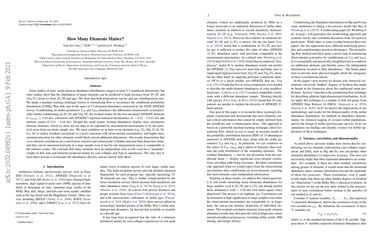How Many Elements Matter?
Some studies of stars' multi-element abundance distributions suggest at least 5-7 significant dimensions, but others show that many elemental abundances can be predicted to high accuracy from [Fe/H] and [Mg/Fe] (or [Fe/H] and age) alone. We show that both propositions can be, and are, simultaneously true. We adopt a machine learning technique known as normalizing flow to reconstruct the probability distribution of Milky Way disk stars in the space of 15 elemental abundances measured by APOGEE. Conditioning on Teff and log g minimizes the differential systematics. After further conditioning on [Fe/H] and [Mg/Fe], the residual scatter for most abundances is $\sigma_{[X/{\rm H}]} \lesssim 0.02$ dex, consistent with APOGEE's reported statistical uncertainties of $\sim$0.01-0.015 dex and intrinsic scatter of 0.01-0.02 dex. Despite the small scatter, residual abundances display clear correlations between elements, which we show are too large to be explained by measurement uncertainties or by the finite sampling noise. We must condition on at least seven elements to reduce correlations to a level consistent with observational uncertainties. Our results demonstrate that cross-element correlations are a much more sensitive probe of hidden structure than dispersion, and they can be measured precisely in a large sample even if star-by-star measurement noise is comparable to the intrinsic scatter. We conclude that many elements have an independent story to tell, even for the "mundane" disk stars and elements produced by core-collapse and Type Ia supernovae. The only way to learn these lessons is to measure the abundances directly, and not merely infer them.
PDF Abstract